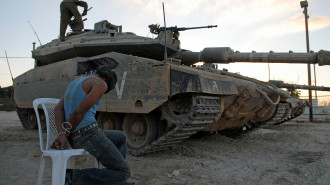UN releases satellite images of destruction in Syria's Aleppo
The release coincides with a stepped-up offensive by Syrian regime forces that are attacking the city from the south in a bid to penetrate its opposition-controlled areas.
Around 275,000 people are trapped in a regime siege on the districts, while pro-Damascus troops push deeper into the rebel territories.
In Geneva, an official with the UN's satellite imagery programme said the new pictures from the rebel-held areas in the eastern half of the city show massive destruction to residential areas, presumably caused by airstrikes.
"Since the ceasefire has broken down, you certainly see an awful lot of new damage or plenty of new damage," said Lars Bromley, a research adviser at UNOSAT.
The images show mostly "formerly blasted and blown-up areas" during Syria's five-and-a-half year war "experiencing a great deal of additional damage", said Bromley.
"To a certain extent you're looking at rubble being pushed around," he told reporters.
Twitter Post
|
[Translation: Satellite images show the Aleppo's schools, roads and buildings destroyed - Photo from Unosat via AP]
The images primarily show before-and-after pictures from mid to late September showing destruction of buildings, including houses, after the short-lived ceasefire broke down.
Several images are from northern Aleppo neighbourhoods, where regime forces have also advanced against rebel fighters battling back.
"Since the ceasefire has broken down, you certainly see an awful lot of new damage or plenty of new damage," Bromley added.
"Remember that the areas that are being bombed have been bombed almost continuously for quite some time. So seeing dramatic images of formerly pristine areas now turned to rubble - you don't see a lot of that."
One image, dated Saturday, shows the damage to a school or athletic facility in Aleppo's Owaija district. Some of the images had a "signature" that airstrikes had done the damage - a large-size crater.
 |
One image, dated Saturday, shows the damage to a school or athletic facility in Aleppo's Owaija district |  |
"Air-dropped munitions are often much larger than anything you would fire on the ground, so a giant crater in the ground is almost certainly an air-dropped munition," Bromley explained.
"Then things like rockets, they will often occur in a row, whereas artillery or mortars will kind of have a different pattern."
"But there is also a lot of overlap, there is a lot of smaller airdropped bombs that will look almost the same as a mortar or an artillery piece," he added.
UNOSAT manager Einar Bjorgo added that places like Aleppo, which has long been the focus of Syria's bitter civil war - now in its sixth year - "are of course complex to analyse because you have a mix of all this".
The images could also provide significant insight after a controversial attack - such as a deadly attack on a UN-backed humanitarian aid convoy west of Aleppo last month.
"With our analysis, we determined that it was an airstrike," Bromley said.
The top US military officer, Marine Gen. Joseph Dunford, chairman of the Joint Chiefs of Staff, told a Senate committee last week that he believes Russia bombed the convoy and said Syrian and Russian aircraft were in the area at the time.
Russia and Syria have denied that they were responsible for the strike.
The UN officials also presented images from Iraq that showed plumes of black smoke from burning oil fields about 15 kilometres [9 miles] south of Mosul that were set aflame as Islamic State group retreated to the city.
UNOSAT generally provides images to UN agencies, such as the refugee agency UNHCR, which is preparing for an expected exodus from IS-held Mosul after Iraq's government announced plans to retake the city by the end of this year.







 Follow the Middle East's top stories in English at The New Arab on Google News
Follow the Middle East's top stories in English at The New Arab on Google News


